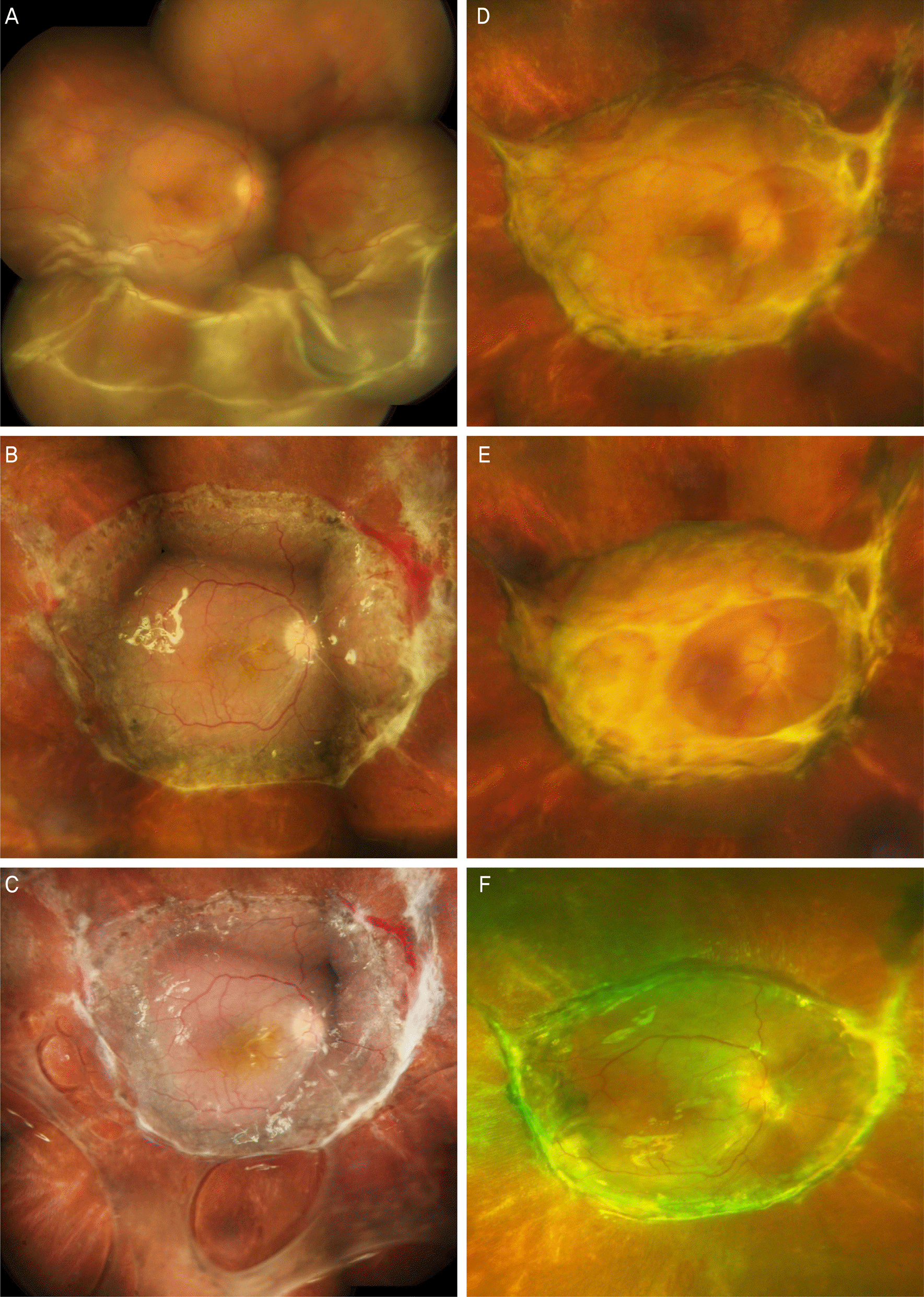Abstract
Purpose
To report the outcomes of relaxing retinectomy for retinal detachment in patients with proliferative vitreoretinopathy (PVR).
Methods
Sixty-four cases of relaxing retinectomy for PVR with a minimum follow-up of 6 months were retrospectively reviewed. The outcomes included achievement of complete retinal reattachment, PVR recurrence, the mean number of additional oper-ations, visual acuity and incidence of postoperative complications. We analyzed the influence of intraoperative factors including lens status, retinectomy extent, additional scleral buckling, and tamponade agent on primary retinal reattachment.
Results
Complete retinal reattachment was achieved in 47 eyes (74.3%) without an additional surgery. PVR recurred in 19 eyes (29.7%) and an additional operation was performed in 17 eyes (26.6%). Fifty-seven (89.1%) eyes showed complete retinal reattachment and 40 eyes (62.5%) had visual acuity of 0.02 or more at the final follow-up visit. Hypotony was the major complication and developed in 10 eyes (15.6%). Eyes undergoing smaller (< 180˚) retinectomy or silicone oil tamponade had higher primary anatomical success rates than larger (≥ 180˚) retinectomy or gas tamponade (p = 0.043 and 0.013, respectively).
Go to : 
References
1. Speicher MA, Fu AD, Martin JP, von Fricken MA. Primary vitrectomy alone for repair of retinal detachments following cataract surgery. Retina. 2000; 20:459–64.

2. Quiram PA, Gonzales CR, Hu W, et al. Outcomes of vitrectomy with inferior retinectomy in patients with recurrent rhegmatogenous retinal detachments and proliferative vitreoretinopathy. Ophthalmology. 2006; 113:2041–7.

3. Kirchhof B. Strategies to influence PVR development. Graefes Arch Clin Exp Ophthalmol. 2004; 242:699–703.

4. Asaria RH, Kon CH, Bunce C, et al. How to predict proliferative vitreoretinopathy: a prospective study. Ophthalmology. 2001; 108:1184–6.
5. Frenzel EM, Neely KA, Walsh AW, et al. A new model of proliferative vitreoretinopathy. Invest Ophthalmol Vis Sci. 1998; 39:2157–64.
7. Tseng JJ, Barile GR, Schiff WM, et al. Influence of relaxing retinotomy on surgical outcomes in proliferative vitreoretinopathy. Am J Ophthalmol. 2005; 140:628–36.

8. Faude F, Lambert A, Wiedemann P. 360 degrees retinectomy in severe anterior PVR and PDR. Int Ophthalmol. 1998-1999; 22:119–23.
9. Iverson DA, Ward TG, Blumenkranz MS. Indications and results of relaxing retinotomy. Ophthalmology. 1990; 97:1298–304.

10. Lewis H, Aaberg TM, Abrams GW. Causes of failure after initial vitreoretinal surgery for severe proliferative vitreoretinopathy. Am J Ophthalmol. 1991; 111:8–14.

11. Morse LS, McCuen BW 2nd, Machemer R. Relaxing retinotomies. Analysis of anatomic and visual results. Ophthalmology. 1990; 97:642–7. discussion 647-8.
12. de Silva DJ, Kwan A, Bunce C, Bainbridge J. Predicting visual outcome following retinectomy for retinal detachment. Br J Ophthalmol. 2008; 92:954–8.

13. Tan HS, Mura M, Oberstein SY, de Smet MD. Primary retinectomy in proliferative vitreoretinopathy. Am J Ophthalmol. 2010; 149:447–52.

14. Lewis H, Aaberg TM. Causes of failure after repeat vitreoretinal surgery for recurrent proliferative vitreoretinopathy. Am J Ophthalmol. 1991; 111:15–9.

15. Lewis H, Aaberg TM. Anterior proliferative vitreoretinopathy. Am J Ophthalmol. 1988; 105:277–84.

16. Grigoropoulos VG, Benson S, Bunce C, Charteris DG. Functional outcome and prognostic factors in 304 eyes managed by retinectomy. Graefes Arch Clin Exp Ophthalmol. 2007; 245:641–9.

17. Han DP, Lewis MT, Kuhn EM, et al. Relaxing retinotomies and retinectomies. Surgical results and predictors of visual outcome. Arch Ophthalmol. 1990; 108:694–7.
18. Schmidt JC, Rodrigues EB, Hoerle S, et al. Primary vitrectomy in complicated rhegmatogenous retinal detachment-a survey of 205 eyes. Ophthalmologica. 2003; 217:387–92.
19. McCuen BW 2nd, Azen SP, Stern W, et al. Vitrectomy with silicone oil or perfluoropropane gas in eyes with severe proliferative vitreoretinopathy. Silicone Study Report 3. Retina. 1993; 13:279–84.
Go to : 
 | Figure 1.Consecutive fundus photos of a 25 year old male patient undergoing 5 repeated operations. (A) Total retinal detachment with extensive subretinal proliferation before surgery. (B) Re-attached retina 2 weeks after 360° relaxing retinectomy (the second operation). (C) Initiation of reproliferation at retinectomy margin 3 weeks after second operation. (D) Preretinal reproliferation 2 weeks after fourth operation. (E) Matured preretinal membrane 4 weeks after fourth operation. (F) Remained tough fibrous ring surrounding the retinectomy site after fifth operation. |
Table 1.
Baseline characteristics of patients undergoing relaxing retinectomy for proliferative vitreoretinopathy
Table 2.
Surgical details of relaxing retinectomy for proliferative vitreoretinopathy
Table 3.
Outcomes at final follow-up visit
Table 4.
Factors predictive of primary anatomical success
| Number (%) | Primary anatomical reattachment (%) | p-value* | |
|---|---|---|---|
| Lens status | 0.556 | ||
| Phakia | 12 (18.8) | 8 (66.7) | |
| Pseudophakia or aphakia | 52 (81.3) | 39 (75.0) | |
| Retinectomy extent | 0.043 | ||
| <180˚ | 20 (31.3) | 18 (90.0) | |
| 180-360˚ | 44 (68.8) | 29 (65.9) | |
| Additional scleral buckling or encircling | 0.497 | ||
| Yes | 49 (76.6) | 37 (75.5) | |
| No | 15 (23.4) | 10 (66.7) | |
| Tamponade type | 0.013 | ||
| Silicone oil | 51 (79.7) | 41 (80.4) | |
| Gas | 13 (20.3) | 6 (46.2) |




 PDF
PDF ePub
ePub Citation
Citation Print
Print


 XML Download
XML Download